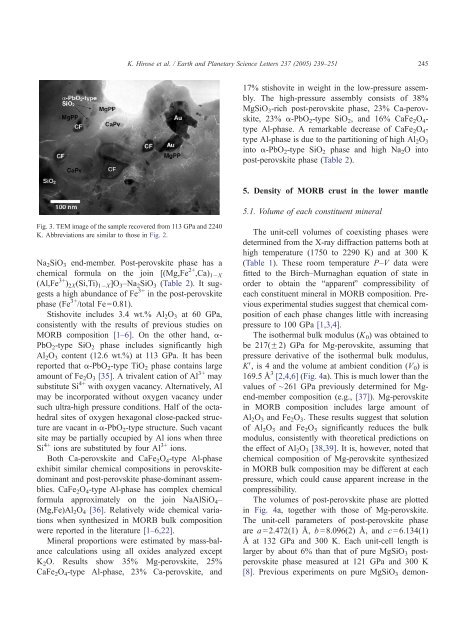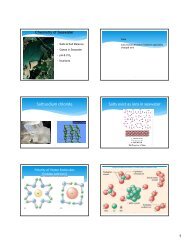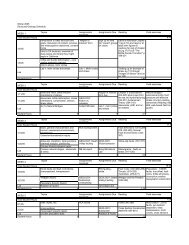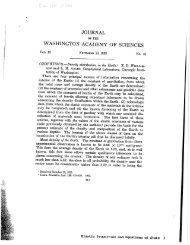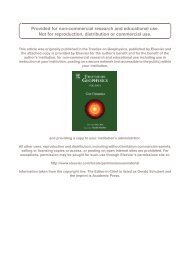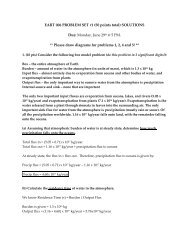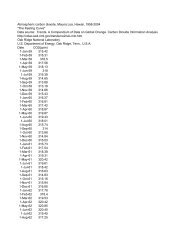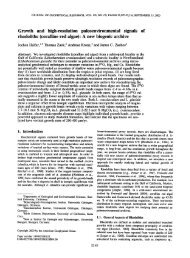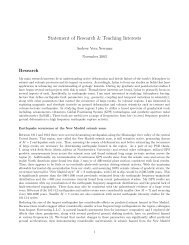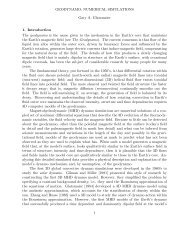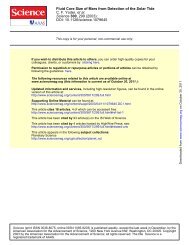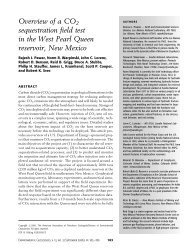Phase transition and density of subducted MORB crust in the lower ...
Phase transition and density of subducted MORB crust in the lower ...
Phase transition and density of subducted MORB crust in the lower ...
You also want an ePaper? Increase the reach of your titles
YUMPU automatically turns print PDFs into web optimized ePapers that Google loves.
K. Hirose et al. / Earth <strong>and</strong> Planetary Science Letters 237 (2005) 239–251 245<br />
Fig. 3. TEM image <strong>of</strong> <strong>the</strong> sample recovered from 113 GPa <strong>and</strong> 2240<br />
K. Abbreviations are similar to those <strong>in</strong> Fig. 2.<br />
Na2SiO3 end-member. Post-perovskite phase has a<br />
chemical formula on <strong>the</strong> jo<strong>in</strong> [(Mg,Fe 2+ ,Ca)1 X<br />
(Al,Fe 3+ ) 2X(Si,Ti) 1 X]O 3–Na 2SiO 3 (Table 2). It suggests<br />
a high abundance <strong>of</strong> Fe 3+ <strong>in</strong> <strong>the</strong> post-perovskite<br />
phase (Fe 3+ /total Fe =0.81).<br />
Stishovite <strong>in</strong>cludes 3.4 wt.% Al2O3 at 60 GPa,<br />
consistently with <strong>the</strong> results <strong>of</strong> previous studies on<br />
<strong>MORB</strong> composition [1–6]. On <strong>the</strong> o<strong>the</strong>r h<strong>and</strong>, a-<br />
PbO2-type SiO2 phase <strong>in</strong>cludes significantly high<br />
Al2O3 content (12.6 wt.%) at 113 GPa. It has been<br />
reported that a-PbO 2-type TiO 2 phase conta<strong>in</strong>s large<br />
amount <strong>of</strong> Fe 2O 3 [35]. A trivalent cation <strong>of</strong> Al 3+ may<br />
substitute Si 4+ with oxygen vacancy. Alternatively, Al<br />
may be <strong>in</strong>corporated without oxygen vacancy under<br />
such ultra-high pressure conditions. Half <strong>of</strong> <strong>the</strong> octahedral<br />
sites <strong>of</strong> oxygen hexagonal close-packed structure<br />
are vacant <strong>in</strong> a-PbO2-type structure. Such vacant<br />
site may be partially occupied by Al ions when three<br />
Si 4+ ions are substituted by four Al 3+ ions.<br />
Both Ca-perovskite <strong>and</strong> CaFe 2O 4-type Al-phase<br />
exhibit similar chemical compositions <strong>in</strong> perovskitedom<strong>in</strong>ant<br />
<strong>and</strong> post-perovskite phase-dom<strong>in</strong>ant assemblies.<br />
CaFe2O4-type Al-phase has complex chemical<br />
formula approximately on <strong>the</strong> jo<strong>in</strong> NaAlSiO4–<br />
(Mg,Fe)Al2O4 [36]. Relatively wide chemical variations<br />
when syn<strong>the</strong>sized <strong>in</strong> <strong>MORB</strong> bulk composition<br />
were reported <strong>in</strong> <strong>the</strong> literature [1–6,22].<br />
M<strong>in</strong>eral proportions were estimated by mass-balance<br />
calculations us<strong>in</strong>g all oxides analyzed except<br />
K2O. Results show 35% Mg-perovskite, 25%<br />
CaFe2O4-type Al-phase, 23% Ca-perovskite, <strong>and</strong><br />
17% stishovite <strong>in</strong> weight <strong>in</strong> <strong>the</strong> low-pressure assembly.<br />
The high-pressure assembly consists <strong>of</strong> 38%<br />
MgSiO 3-rich post-perovskite phase, 23% Ca-perovskite,<br />
23% a-PbO2-type SiO2, <strong>and</strong> 16% CaFe2O4type<br />
Al-phase. A remarkable decrease <strong>of</strong> CaFe2O4type<br />
Al-phase is due to <strong>the</strong> partition<strong>in</strong>g <strong>of</strong> high Al2O3<br />
<strong>in</strong>to a-PbO2-type SiO2 phase <strong>and</strong> high Na2O <strong>in</strong>to<br />
post-perovskite phase (Table 2).<br />
5. Density <strong>of</strong> <strong>MORB</strong> <strong>crust</strong> <strong>in</strong> <strong>the</strong> <strong>lower</strong> mantle<br />
5.1. Volume <strong>of</strong> each constituent m<strong>in</strong>eral<br />
The unit-cell volumes <strong>of</strong> coexist<strong>in</strong>g phases were<br />
determ<strong>in</strong>ed from <strong>the</strong> X-ray diffraction patterns both at<br />
high temperature (1750 to 2290 K) <strong>and</strong> at 300 K<br />
(Table 1). These room temperature P–V data were<br />
fitted to <strong>the</strong> Birch–Murnaghan equation <strong>of</strong> state <strong>in</strong><br />
order to obta<strong>in</strong> <strong>the</strong> bapparentQ compressibility <strong>of</strong><br />
each constituent m<strong>in</strong>eral <strong>in</strong> <strong>MORB</strong> composition. Previous<br />
experimental studies suggest that chemical composition<br />
<strong>of</strong> each phase changes little with <strong>in</strong>creas<strong>in</strong>g<br />
pressure to 100 GPa [1,3,4].<br />
The iso<strong>the</strong>rmal bulk modulus (K 0) was obta<strong>in</strong>ed to<br />
be 217(F2) GPa for Mg-perovskite, assum<strong>in</strong>g that<br />
pressure derivative <strong>of</strong> <strong>the</strong> iso<strong>the</strong>rmal bulk modulus,<br />
KV, is 4 <strong>and</strong> <strong>the</strong> volume at ambient condition (V0) is<br />
169.5 A˚ 3 [2,4,6] (Fig. 4a). This is much <strong>lower</strong> than <strong>the</strong><br />
values <strong>of</strong> ~261 GPa previously determ<strong>in</strong>ed for Mgend-member<br />
composition (e.g., [37]). Mg-perovskite<br />
<strong>in</strong> <strong>MORB</strong> composition <strong>in</strong>cludes large amount <strong>of</strong><br />
Al 2O 3 <strong>and</strong> Fe 2O 3. These results suggest that solution<br />
<strong>of</strong> Al 2O 3 <strong>and</strong> Fe 2O 3 significantly reduces <strong>the</strong> bulk<br />
modulus, consistently with <strong>the</strong>oretical predictions on<br />
<strong>the</strong> effect <strong>of</strong> Al2O3 [38,39]. It is, however, noted that<br />
chemical composition <strong>of</strong> Mg-perovskite syn<strong>the</strong>sized<br />
<strong>in</strong> <strong>MORB</strong> bulk composition may be different at each<br />
pressure, which could cause apparent <strong>in</strong>crease <strong>in</strong> <strong>the</strong><br />
compressibility.<br />
The volumes <strong>of</strong> post-perovskite phase are plotted<br />
<strong>in</strong> Fig. 4a, toge<strong>the</strong>r with those <strong>of</strong> Mg-perovskite.<br />
The unit-cell parameters <strong>of</strong> post-perovskite phase<br />
are a =2.472(1) A˚ , b =8.096(2) A˚ , <strong>and</strong> c =6.134(1)<br />
A˚ at 132 GPa <strong>and</strong> 300 K. Each unit-cell length is<br />
larger by about 6% than that <strong>of</strong> pure MgSiO3 postperovskite<br />
phase measured at 121 GPa <strong>and</strong> 300 K<br />
[8]. Previous experiments on pure MgSiO3 demon-


